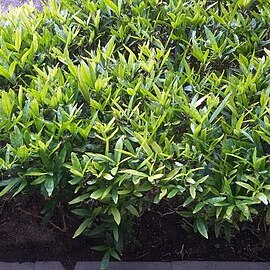Shrubs, 0.5-3 m tall; branches generally slender, angled to subterete, puberulent to glabrescent. Leaves opposite or ternate with arrangement often variable on a branch, subsessile to shortly petiolate; petiole to 5 mm, puberulent to glabrous; blade drying thinly leathery, narrowly lanceolate, narrowly elliptic, elliptic-spatulate, or linear-lanceolate, 3-12 × 0.4-2.3 cm, adaxially glabrous, abaxially puberulent to glabrous, base acute and often decurrent, margin thickened and often thinly revolute, apex acute to obtuse; secondary veins 9-13 pairs, in abaxial axils without domatia; stipules calyptrate, conical, 7-10 mm, splitting along one side for 3/4 or more of length, glabrous. Flowers solitary, pseudoaxillary or terminal; peduncles 5-6 mm, glabrous. Calyx glabrous; ovary portion ellipsoid to cylindrical, 5-6 mm, longitudinally 5-8-ridged; limb with basal tubular portion 4-6 mm; lobes 5-8, linear to narrowly lanceolate, 7-15 mm, keeled, acute. Corolla outside glabrous; tube cylindrical, 35-65 × 3-4 mm; lobes 5-8, oblong-obovate, 25-35 × 10-15 mm, obtuse. Fruiting pedicels to 2 cm. Berry yellow or orange-red, ellipsoid-oblong to ellipsoid, 1.5-2.5 × 1-1.3 cm, with 5-8 weak to developed longitudinal ridges, with persistent calyx lobes to 2 cm; seeds 2-3 mm. Fl. Apr-Aug, fr. May-Jan.
More
A shrub. It grows 1-3 m tall. The branches are slender and angled. The leaves are often opposite. They are narrowly oval and 3-12 cm long by 1-2 cm wide. They are often hairy underneath. The edges often curl under. Flowers occur singly. They are near the axils at the ends of the branches. The fruit are yellow to orange or red berries. They are oval and 2-3 cm long by 1 cm wide. They have slight ridges along them.

